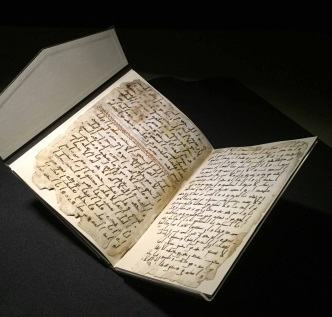
In 2015, a discovery at the University of Birmingham sent ripples of excitement across the Muslim world and the academic community alike. Nestled within the university’s Mingana Collection, a treasure trove of Middle Eastern manuscripts, were two parchment leaves of profound significance: fragments of one of the oldest known Qurans in the world. These fragments, known today as the Birmingham Quran manuscript, have become a source of inspiration, scholarly inquiry, and renewed faith for Muslims worldwide.
Radiocarbon dating conducted by the University of Oxford revealed that the parchment used for these Quranic fragments dates back to between 568 and 645 AD, with a 95.4% probability. This timeline overlaps with the lifetime of Prophet Muhammad (peace be upon him), who lived from 570 to 632 AD. This means the parchment could have been written either during the Prophet’s life or in the early years following his passing.
The manuscript contains parts of Surahs 18 to 20, written in the Hijazi script, an early form of Arabic writing. This style is notable for its simplicity and elegance, characteristics that align with early Islamic texts. Scholars have speculated that these fragments may have been produced during the Caliphate of Abu Bakr (RA), who initiated the compilation of the Quran following the Prophet’s death.
Image of Radiocarbon result from Birmingham University
The Birmingham Quran fragments offer compelling evidence for the remarkable preservation of the Quranic text. From the very beginning of Islamic history, the Quran was memorized and written down meticulously, ensuring its authenticity across generations. These fragments align with the Uthmanic Quran, the standardized compilation of the Quran overseen by the third Caliph, Uthman ibn Affan (RA). This consistency is a testament to the divine promise in the Quran:
“Indeed, it is We who sent down the Quran, and indeed, We will be its guardian.” (Surah Al-Hijr, 15:9)
The physical attributes of the manuscript further highlight the structured approach early Muslims took to preserve the Quran. The leaves measure 343 mm by 258 mm (approximately 13½” by 10¼”) and feature clear chapter divisions and verse endings. Such precision demonstrates the reverence early Muslims had for the Quran and their commitment to its accurate transmission.
For Muslims, the discovery reaffirms the Quran’s authenticity and its miraculous preservation over 1,400 years. For scholars, it opens new avenues to explore the textual history of the Quran. The manuscript’s early dating challenges assumptions about how the Quran was compiled and transmitted, offering a tangible link to Islam’s formative years.
Housed in the Cadbury Research Library at the University of Birmingham, the manuscript has attracted global attention. Its significance goes beyond the Muslim community, drawing admiration from historians, linguists, and cultural enthusiasts. It serves as a bridge between faith and academic inquiry, showing how Islam’s early history is deeply interwoven with the preservation of its holy text.
The Birmingham Quran manuscript isn’t just an artifact; it’s a reminder of the enduring legacy of Islamic scholarship. It reflects the unity of the Muslim ummah during the earliest days of Islam, where efforts to preserve the Quran transcended personal or tribal interests. In today’s fragmented world, this unity is an example for us to draw inspiration from.
Moreover, this discovery underscores the importance of preserving Islamic heritage. Whether through modern libraries, digital archives, or personal collections, Muslims today have a responsibility to safeguard the rich legacy left by our predecessors.
If you’re in the UK, a visit to the University of Birmingham offers a rare opportunity to witness this historic artifact up close. Exhibitions often include contextual information about the Quran’s early history, making it an enriching experience for Muslims and non-Muslims alike. For those unable to visit, online resources and documentaries about the Birmingham Quran provide an excellent alternative.
The discovery of the Birmingham Quran manuscript invites Muslims to reflect on the Quran’s timeless message and its miraculous preservation. It also challenges us to deepen our relationship with the Quran, not just as a text to be recited, but as a guide for our daily lives.
Let this discovery inspire you to explore the Quran more deeply, share its wisdom with others, and contribute to the preservation of Islamic knowledge. As the Quran says:
“And We have certainly made the Quran easy for remembrance, so is there any who will remember?” (Surah Al-Qamar, 54:17)
The Birmingham Quran manuscript is more than an ancient fragment—it’s a living testament to the truth of Islam and the meticulous efforts of the early Muslim community. Its discovery is a reminder of the divine promise to safeguard the Quran and an invitation for us to renew our connection with this sacred text. Whether through study, memorization, or reflection, let’s strive to honor the legacy of the Quran in our lives.
Explore. Reflect. Act. Let the timeless wisdom of the Quran shape your journey.